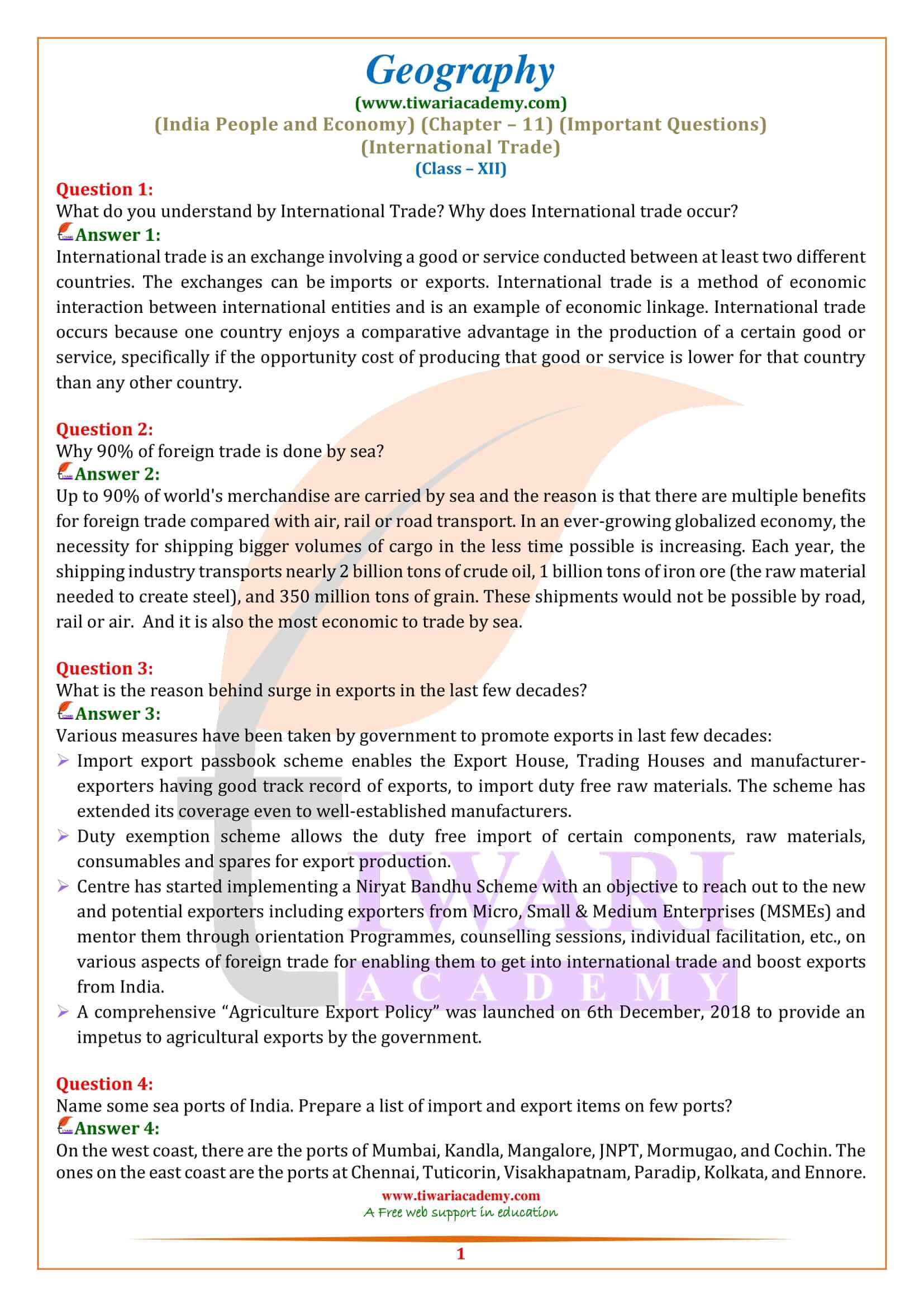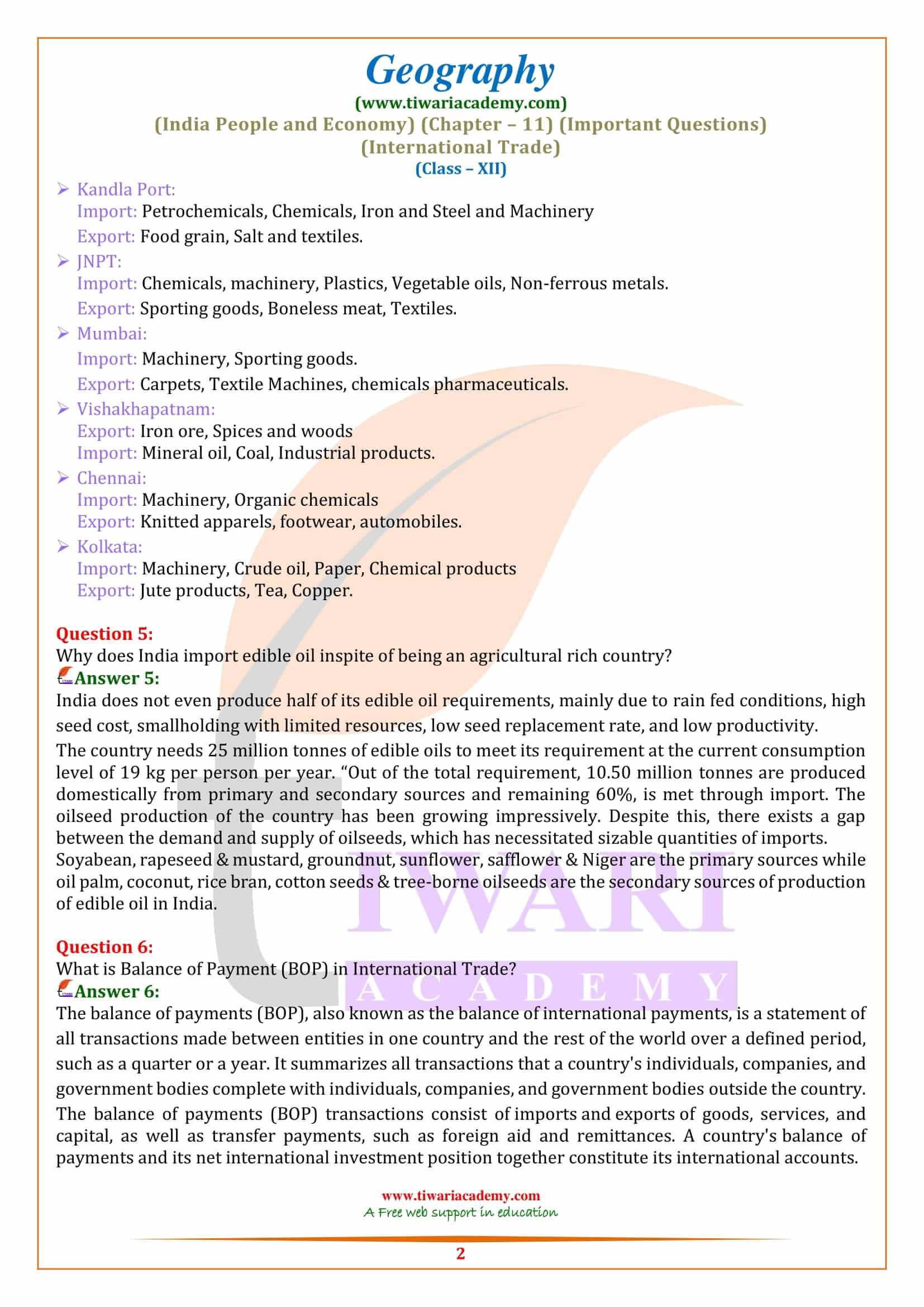Class 12 Geography Part 2 Chapter 11 Important Questions of International Trade with suitable explanation and answers designed for CBSE exams 2024-25. Class 12 Geography Chapter 11 Extra questions are helpful for the revision of the chapter and to get confident in part 2 book India People and Economy.
Class 12 Geography Chapter 11 Important Questions
Class 12 Geography Chapter 11 Important Extra Question Answers
What is Balance of Payment (BOP) in International Trade?
The balance of payments (BOP), also known as the balance of international payments, is a statement of all transactions made between entities in one country and the rest of the world over a defined period, such as a quarter or a year. It summarizes all transactions that a country’s individuals, companies, and government bodies complete with individuals, companies, and government bodies outside the country.
The balance of payments (BOP) transactions consist of imports and exports of goods, services, and capital, as well as transfer payments, such as foreign aid and remittances. A country’s balance of payments and its net international investment position together constitute its international accounts.
Why does India import edible oil inspite of being an agricultural rich country?
India does not even produce half of its edible oil requirements, mainly due to rain fed conditions, high seed cost, smallholding with limited resources, low seed replacement rate, and low productivity. The country needs 25 million tonnes of edible oils to meet its requirement at the current consumption level of 19 kg per person per year. “Out of the total requirement, 10.50 million tonnes are produced domestically from primary and secondary sources and remaining 60%, is met through import.
The oilseed production of the country has been growing impressively. Despite this, there exists a gap between the demand and supply of oilseeds, which has necessitated sizable quantities of imports. Soyabean, rapeseed & mustard, groundnut, sunflower, safflower & Niger are the primary sources while oil palm, coconut, rice bran, cotton seeds & tree-borne oilseeds are the secondary sources of production of edible oil in India.
What is the reason behind surge in exports in the last few decades?
Various measures have been taken by government to promote exports in last few decades:
- Import export passbook scheme enables the Export House, Trading Houses and manufacturer-exporters having good track record of exports, to import duty free raw materials. The scheme has extended its coverage even to well-established manufacturers.
- Duty exemption scheme allows the duty free import of certain components, raw materials, consumables and spares for export production.
- Centre has started implementing a Niryat Bandhu Scheme with an objective to reach out to the new and potential exporters including exporters from Micro, Small & Medium Enterprises (MSMEs) and mentor them through orientation Programmes, counselling sessions, individual facilitation, etc., on various aspects of foreign trade for enabling them to get into international trade and boost exports from India.
- A comprehensive “Agriculture Export Policy” was launched on 6th December, 2018 to provide an impetus to agricultural exports by the government.
Why 90% of foreign trade is done by sea?
Up to 90% of world’s merchandise are carried by sea and the reason is that there are multiple benefits for foreign trade compared with air, rail or road transport. In an ever-growing globalized economy, the necessity for shipping bigger volumes of cargo in the less time possible is increasing. Each year, the shipping industry transports nearly 2 billion tons of crude oil, 1 billion tons of iron ore (the raw material needed to create steel), and 350 million tons of grain. These shipments would not be possible by road, rail or air. And it is also the most economic to trade by sea.
What do you understand by International Trade? Why does International trade occur?
International trade is an exchange involving a good or service conducted between at least two different countries. The exchanges can be imports or exports. International trade is a method of economic interaction between international entities and is an example of economic linkage. International trade occurs because one country enjoys a comparative advantage in the production of a certain good or service, specifically if the opportunity cost of producing that good or service is lower for that country than any other country.




